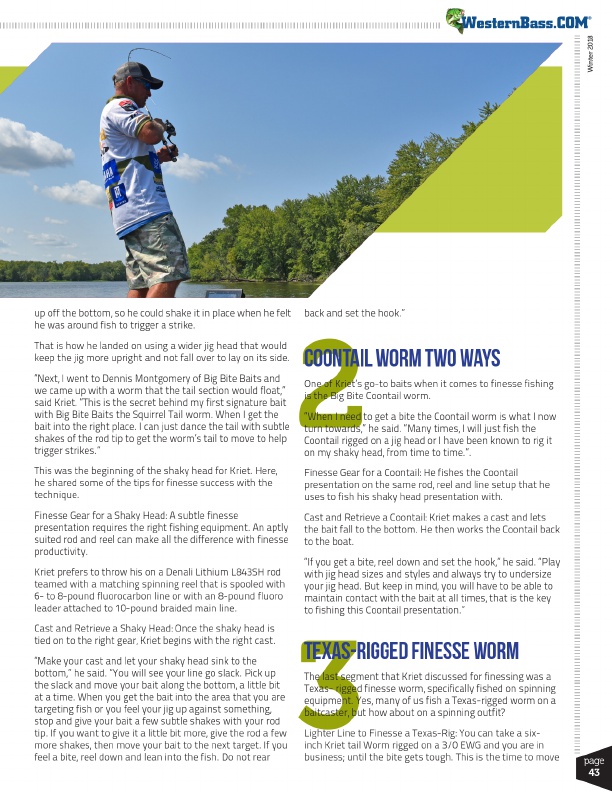
®
Winter 2018
up off the bottom, so he could shake it in place when he felt back and set the hook.” he was around fish to trigger a strike.
2
COONTAIL WORM TWO WAYS
That is how he landed on using a wider jig head that would keep the jig more upright and not fall over to lay on its side.
“Next, I went to Dennis Montgomery of Big Bite Baits and we came up with a worm that the tail section would float,” said Kriet. “This is the secret behind my first signature bait with Big Bite Baits the Squirrel Tail worm. When I get the bait into the right place. I can just dance the tail with subtle shakes of the rod tip to get the worm’s tail to move to help
One of Kriet’s go-to baits when it comes to finesse fishing is the Big Bite Coontail worm.
“When I need to get a bite the Coontail worm is what I now turn towards,” he said. “Many times, I will just fish the Coontail rigged on a jig head or I have been known to rig it
trigger strikes.”
on my shaky head, from time to time.”.
This was the beginning of the shaky head for Kriet. Here, he shared some of the tips for finesse success with the technique.
Finesse Gear for a Coontail: He fishes the Coontail presentation on the same rod, reel and line setup that he uses to fish his shaky head presentation with.
Finesse Gear for a Shaky Head: A subtle finesse presentation requires the right fishing equipment. An aptly suited rod and reel can make all the difference with finesse productivity.
Kriet prefers to throw his on a Denali Lithium L843SH rod teamed with a matching spinning reel that is spooled with 6- to 8-pound fluorocarbon line or with an 8-pound fluoro leader attached to 10-pound braided main line.
Cast and Retrieve a Coontail: Kriet makes a cast and lets the bait fall to the bottom. He then works the Coontail back to the boat.
“If you get a bite, reel down and set the hook,” he said. “Play with jig head sizes and styles and always try to undersize your jig head. But keep in mind, you will have to be able to maintain contact with the bait at all times, that is the key to fishing this Coontail presentation.”
Cast and Retrieve a Shaky Head: Once the shaky head is
3
TEXAS-RIGGED FINESSE WORM
tied on to the right gear, Kriet begins with the right cast.
“Make your cast and let your shaky head sink to the bottom,” he said. “You will see your line go slack. Pick up the slack and move your bait along the bottom, a little bit at a time. When you get the bait into the area that you are targeting fish or you feel your jig up against something, stop and give your bait a few subtle shakes with your rod tip. If you want to give it a little bit more, give the rod a few more shakes, then move your bait to the next target. If you
The last segment that Kriet discussed for finessing was a Texas- rigged finesse worm, specifically fished on spinning equipment. Yes, many of us fish a Texas-rigged worm on a baitcaster, but how about on a spinning outfit?
Lighter Line to Finesse a Texas-Rig: You can take a six- inch Kriet tail Worm rigged on a 3/0 EWG and you are in
feel a bite, reel down and lean into the fish. Do not rear
business; until the bite gets tough. This is the time to move
page 43